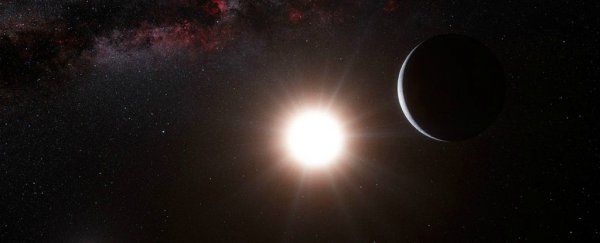Alpha Centauri bb, an Earth-like planet orbiting our closest star, has just vanished. In fact, a new study suggests it never actually existed outside of a blip in the data.
The planet was discovered in 2012, and it was a pretty big deal at the time. According to researchers' best estimates, Alpha Centauri bb appeared to have a mass similar to Earth and was orbiting its star at a distance similar to Mercury.
Best of all, it was only 4.3 light-years away – a whole lot closer than most other Earth-like exoplanets – and existed in a star system that had housed the science-fiction characters of Avatar and Transformers.
But a year after its discovery, a separate group of researchers called the discovery into question, when they found only weak evidence that the planet existed. And now a new study suggests that Alpha Centauri bb was never more than a 'ghost' in the data.
The research serves as a cautionary tale to astrophysicists hunting for evidence of planets orbiting distant stars, and reminds us of how hard it is to work out what's going on using sporadic data taken from distant star systems.
Planets are usually detected in two ways, by scientists observing a dip in the light from a star – a sign of a planet orbiting in front of it – or by noticing a 'wobble' in a star, which suggests that it's being pulled around by a small planet in orbit.
The wobble system, formerly known as radial velocity method, is what was used to detect Alpha Centauri bb, and in the past it's been used to reliably identify a lot of larger planets.
But when we're talking about planets as small as Earth, the new study shows that it can be incredibly challenging to distinguish a genuine signal from the background noise, especially if the star system isn't being monitored constantly, as Alpha Centauri wasn't.
The team, led by graduate student Vinesh Rajpaul from the University of Oxford, was able to show that subtle patterns of light caused by non-planetary happenings in the star system – for example, the pull of other stars or activity on the star's surface – could be mistaken for a planet.
They demonstrated this by creating a simulation of a star with no planet, and then observed it randomly.
"When we generated synthetic data, the planet popped up exactly, even though there was no planet," Rajpaul told National Geographic.
Xavier Dumusque from the Harvard-Smithsonian Centre for Astrophysics in the US, who led the team that discovered Alpha Centauri bb, admitted that Rajpaul and his team have a point.
"This is really good work," said Xavier. "We are not 100 percent sure, but probably the planet is not there."
The research has been pre-released in ArXiv, and will soon be published in the Monthly Notices of the Royal Astronomical Society.
The good news is that most exoplanets won't be at risk of this type of mistake, as they've been detected by Kepler, a spacecraft that stares constantly at one patch of sky for years, which means it's unlikely to be tricked by background noise.
We just need to be more careful in future with the planets detected using telescopes here on Earth, and make sure that they're the real thing, before we get too excited.
